Canadian TEWT, German roadblock, British trenches
Posted: 26 February 2013 18:42
A Canadian TEWT exercise held in 1944 posed problems for reconnaissance units running into a German roadblock. The scenario was imaginary, but a visit to the site yielded unexpected results.
A TEWT is a Tactical Exercise Without Troops; this is simply a scenario being played out on maps or on the sand table by commanders without the need to actually organise troop manoeuvres. Sometimes those involved in the TEWT might actually walk the ground in order to appreciate the tactical situation.
Last week I chanced upon documents relating to one particular TEWT in the war diary of a Canadian Armoured Car Regiment stationed in East Sussex. It was 28th June 1944 and the regiment in question was awaiting its turn to proceed over to Normandy to take part in the Second Front that had opened just three weeks before.
For the purposes of the TEWT, England was Northern France, the Canadians were advancing and the Germans were the defenders; the days when exercise scenarios set the British/Canadians as the defenders and the Germans as the invaders of Britain were long gone.
The TEWT's scenario was as follows:
Contact with the enemy has been lost...Speed is essential to the success of the operation and 'C' Squadron has been ordered to act boldly and, if necessary, carry out close recce of enemy positions covering the Divisional thrust line in order that they may be speedily dealt with.Leading troop of 'C' Sqn...is fired on by multiple flak gun as it reaches road junction...Commander appreciates he has run into enemy outpost line, based on the small river and immediately orders close recce of the enemy position.
As a former member of a recce unit myself, I know that sometimes locating the enemy requires what is nowadays referred to as advance to contact, i.e., move forward until the enemy starts firing at you; you then know where they are.
The war diary entry for 28 June adds the following detail:
The TEWT was carried out on the ground in the Regimental area and was not the most favourable position but choosing the ground had to be based on transportation facilities. All Squadron Commanders and seconds-in-command were present and a very interesting discussion followed.
The ground chosen was a fork in a road just north of the 'small river' as shown in the photograph below; the white fences indicate where the stream passes through a culvert under the road.
The transport issues that lead to this junction being chosen were probably compounded by the sheer volume of military traffic on local roads; there was a petrol depot serving an entire armoured division less than a mile away.

The TEWT documents even give us a sketch map of the 'German' defensive position of the junction. The graphic below is based on this sketch; for some reason, the stream and culvert are not marked. The 'possible diversion' route is possible in reality; a gentle slope down to a point where the stream can be forded.
For the purpose of the TEWT, mines have been laid and a crater blown in the road to make it impassable. The MG42 was the fearsome German machine gun that had a rate of fire of 1,200 rounds per minute.
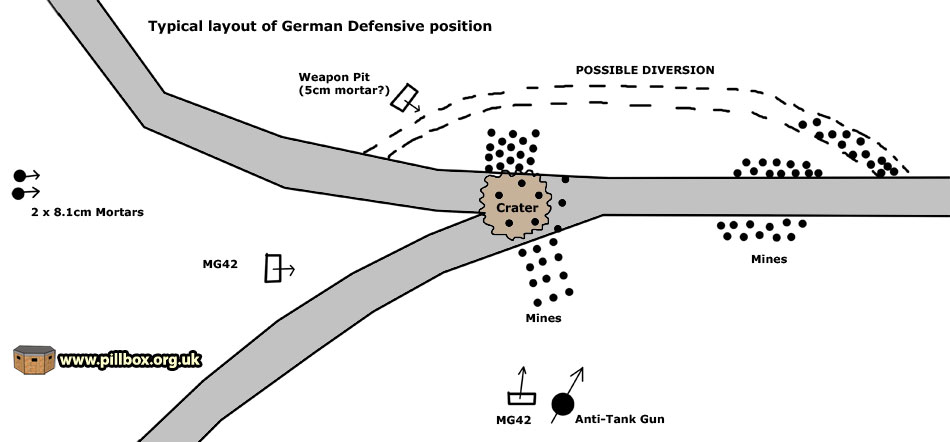
Knowing full well that the scenario and defences on the sketch map were fictional, I nevertheless decided to have a look at the area, stopping off here briefly after having conducted some fieldwork just down the road.
Parking up in a layby just south of the position, I walked up the lane to the fork and tramped up the slope to look back down the road from the position where an MG42 is marked on the sketch in the fork. I was glad that the police officer who happened to be driving past at that moment just stared at me, used his powers of discretion and carried on. Had he enquired what I was doing, he would have been regaled with how I was looking for non-existent German Army defence works.
I was, however, pleasantly surprised to find myself staring a slit trench. I then noticed another that was pretty much at the spot at which the MG42 pit is marked on the map!
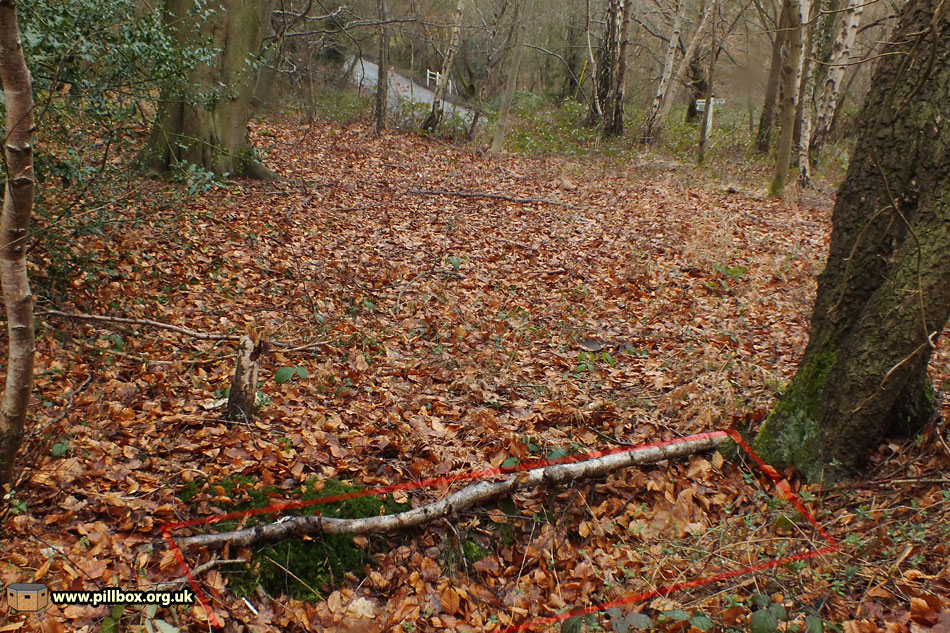
I found that these were not isolated trenches; a quick scout around the locality revealed a total of nine slits. The photo below shows one right next to one of the lanes; this is probably the closest I've seen an 'open' slit trench to a road.
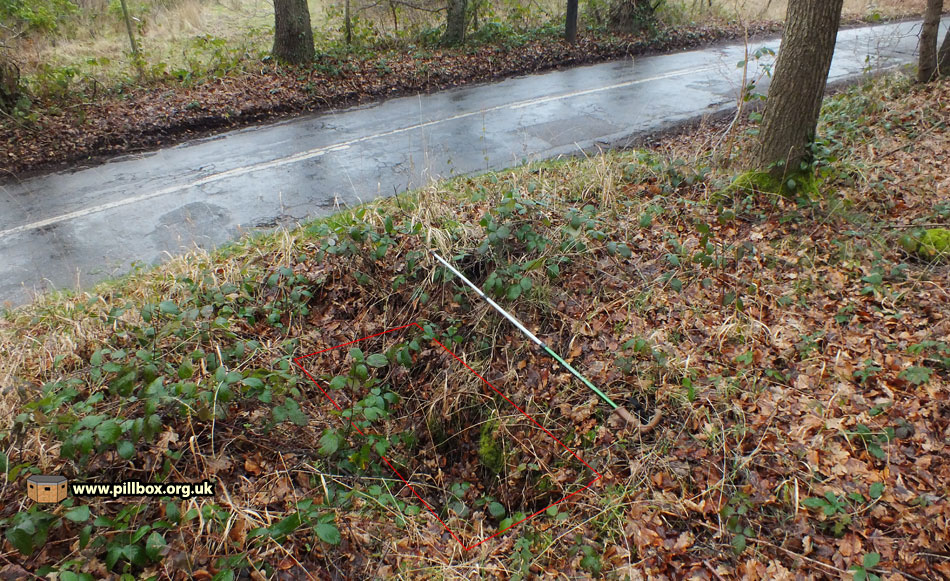
The photo below shows a pair of trenches at the rear of the position. These had both been 'squashed' making them appear narrower at ground level, but probably because they were also the deepest - about 2-3ft - and collapsing inward. The other trenches have been partially or almost completely backfilled, helping them maintain their original dimensions on the ground. The trench in the background has an old metal gatepost sticking out of it.
The rain smear on the camera lens at right indicates the weather conditions, making only basic recording possible, as my clipboard was getting soggy and the ink starting to run.
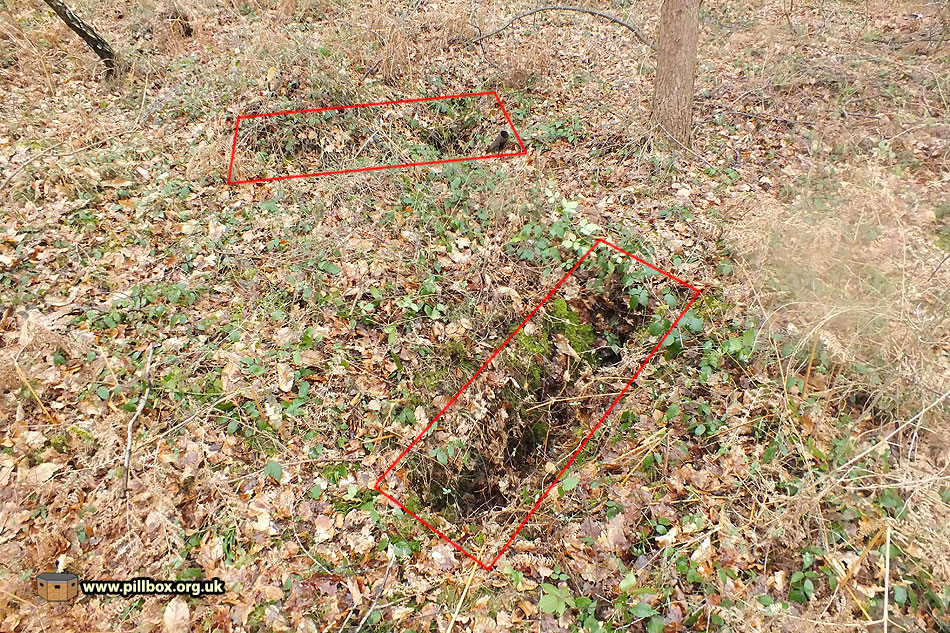
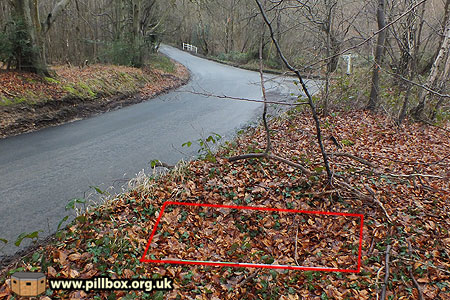
The trenches cover the road junction from all directions; this leads me to speculate that they formed part of the 1940-41 anti-invasion defences and that the road was blocked here.
At this point in time, I have no documentary evidence of a roadblock here as this road was just outside my area of focus until a reorganisation of boundaries took place in 1943.
I suspect that the presence of these trenches may even have influenced the TEWT scenario.
I went in search of the 5cm mortar pit on the other side of the road but wasn't surprised that there was no evidence; this one probably was imaginary.
However, I was more than satisfied with my ten minutes of fieldwork - and I learned an important lesson. By investigating a fictional position I ended up finding a genuine one that would probably otherwise have gone unrecorded!
- Pete

Email:
Blog Latest

Bishopstone reveals its pillbox secrets
18 October 2021

Pillbox or Observation Post?
10 June 2020

Uncovering the hidden secrets of a pillbox
8 June 2019

Review of 2018
31 December 2018

Wartime Christmas in East Sussex (2)
24 December 2018
Jargon-buster
Slit trench
Small, narrow trench designed to provide protection against shrapnel and other battlefield hazards. Technically distinct from a weapon pit (which was intended soley as a defensive position) slit trenches were also used as defence works.
War diary
A record of events kept by all units from the point of mobilisation. A diary's contents vary enormously from unit to unit; some give detailed entries by the hour on a daily basis while others merely summarise events on a weekly/monthly basis.
This site is copyright © Peter Hibbs 2006 - 2024. All rights reserved.
Hibbs, Peter Canadian TEWT, German roadblock, British trenches (2024) Available at: http://pillbox.org.uk/blog/216718/ Accessed: 27 July 2024
The information on this website is intended solely to describe the ongoing research activity of The Defence of East Sussex Project; it is not comprehensive or properly presented. It is therefore NOT suitable as a basis for producing derivative works or surveys!